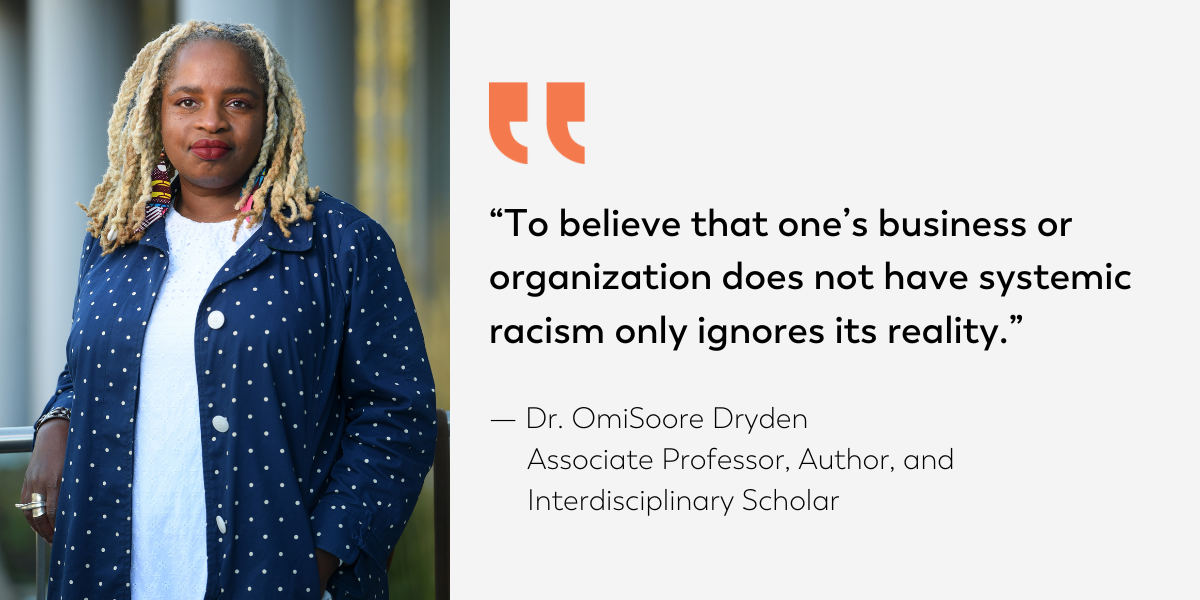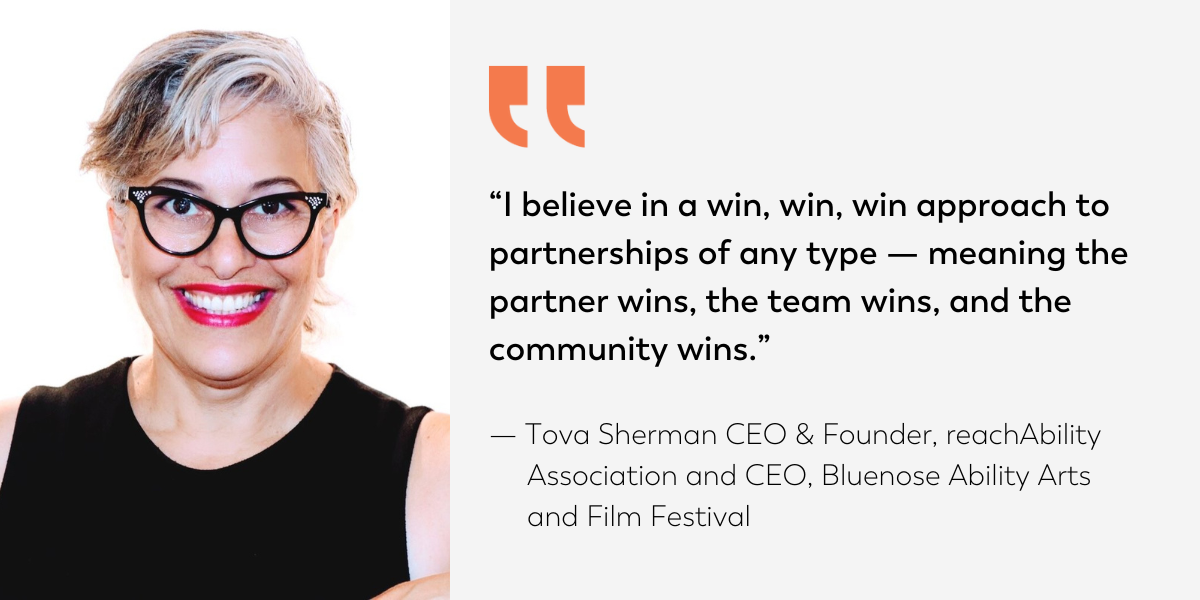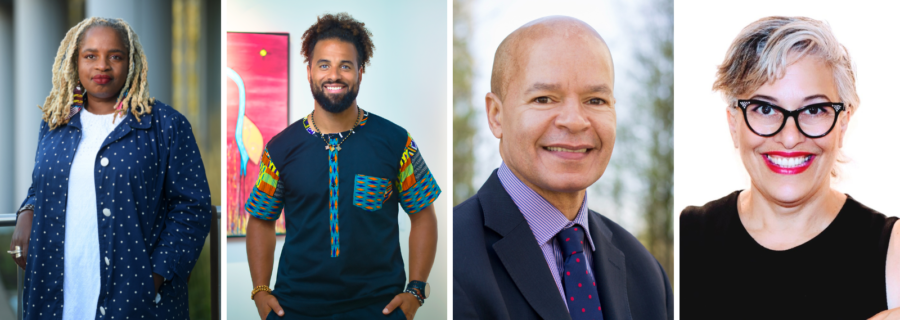Diving into the dynamic world of DEA&I — with simple realities in mind.
Author’s Note: I grew up in small-town Ontario and moved to Halifax a year and a half ago with my partner, who was born and raised in Cape Breton. I have an invisible disability and am a quiet member of the 2SLGBTQ+ community. I’m also nearly eight months pregnant.
Experiencing accessibility and inclusion in my workplace (the phenomenally welcoming Halifax Chamber of Commerce) looks different for me when compared to each of my colleagues. It probably looks very different from your perception and in your workplace, too.
Navigating individual experience, bias, and perception can make Diversity, Equity, Accessibility, and Inclusion (DEA&I) feel like a complex field of work. DEA&I brings together extraordinarily personal experiences, challenges, and triumphs into the stereotypically serious and unemotional realm of business.
It’s understandable then that business owners may feel intimidated when it comes to practicing DEA&I. How can you make sure your employees, with all their individual experiences, feel safe and welcome?
There are few easy answers when it comes to implementing DEA&I in meaningful and actionable ways. Every workplace — and every team member within that workplace — is different. It’s vital that our local business community opens conversations, asks questions, and pushes further.
To support these efforts, the Halifax Chamber will be hosting our first-ever SURGE Conference on March 24. The half-day event brings together Halifax businesses on the path to inclusion and understanding. The conference will be led by a variety of leaders working in fields related to DEA&I.
We spoke with a number of these leaders ahead of the conference to get the conversation started. Unsurprisingly, each of them offers a slightly different take on what DEA&I really looks like and how it operates in the workplace. They all agree, however, that as complicated as DEA&I work may be, it is essential that businesses and organizations start ongoing (sometimes difficult) conversations that lead to realistic, tangible action.

Aren’t things okay as they are?
For those working in DEA&I, getting businesses and organizations on board can be the first hurdle. David Divine is a consultant and researcher who specializes in social work, race relations, social housing, diversity, and inclusion. Divine discusses his approach when working with businesses:
“They may wish to explore my suggestions in order to move their business forward, if they feel the business needs to move forward at all,” he says. “Some businesses feel they’re doing fine as they are and that they don’t need to do anything else. They’re making the requisite amount of profit. The stakeholders are happy, and therefore, why should they change?”
In response to these businesses, Divine focuses on what is missing in a diverse workforce. “Diversity is not a question of ticking boxes about how many Black, Indigenous, or individuals with disabilities you employ,” he says. “Diversity is about working with difference and capturing the potential of that set of differences within your workforce. They can feed off one another, inspire one another, and help each other to learn in a variety of ways. It can result in different ways of doing your work and different ways of thinking about your business’ products or services. And that must be positive.”
Dr. OmiSoore Dryden will be providing the keynote address at the SURGE Conference. Dr. Dryden is a Black queer femme and associate professor at Dalhousie University. She is also the James R Johnston Endowed Chair in Black Canadian Studies, Faculty of Medicine, Interim Director of the newly established Black Studies in STEMM (Science, Technology, Engineering, Mathematics, and Medicine) Research Institute at Dalhousie University, and the co-lead of the new national organization — The Black Health Education Collaborative.
Dr. Dryden reflects on her work at the Centre for Race & Ethnic Relations at York University in the 1990s. “The tools we used focused on changes in decision making, diversity of people and diversity of thought,” she says. “At this time, not many people were familiar with Anti-Racist leadership.”
Pointing out racism and working to address it at all levels of the organization was considered “out of the box,” says Dr. Dryden. “There was a belief then that speaking about the realities of racism is what caused people to experience racism,” she continues. “What was similar then and now is the assumption that naming and identifying racist behaviours and actions is unprofessional.”
In recent years, businesses and organizations have developed roles specific to DEA&I. “In this work, Black people, Indigenous people, and people of colour — including those who are queer and trans — may be hired in a position to create and champion change,” says Dr. Dryden. “But they are met with obstacles within the very institutions that prevent that change from actually occurring.”
For organizational, systemic change to occur is typically “the exception and not the rule,” says Dr. Dryden. “Anti-racism leadership is still needed. This requires brave work to actually hold people accountable regarding anti-Black racism,” she says. “It means understanding that systemic racism already exists within the business or organization. To believe that one’s business or organization does not have systemic racism only ignores its reality.”
Once a business or organization accepts that change needs to happen in their workplace, it becomes a matter of moving past empty statements. “There is a disconnect between the institution’s public claims to commit to equity, diversity, and inclusion and the internal practices that ultimately stall or obstruct the process,” says Dr. Dryden. “Thus, the public statements are seen to do more work than what is actually occurring.”
Effort also needs to come from all levels of the organization. “While a senior leader may be committed to EDI, they are often not the ones who are given the work to make it happen,” says Dr. Dryden. “Hiring appropriate people is important, but so too is filing other positions through the organization with people who are also committed to this change. The missing step is how to encourage employees at all levels to take up the work of EDI in the workplace and how to weave it throughout all aspects of the business.”

Considering motive and values
Data and research can be helpful tools when it comes to getting businesses on board with DEA&I. But the team at Placemaking 4G — who will also be participating in the SURGE Conference — emphasize businesses take a careful look at their motivations. “‘How do I diversify my organization?’ is something we get asked often at Placemaking 4G,” says Bradley Daye, Co-Founder and Co-CEO.
“A diverse and inclusive team is the outcome of successful cultural and systemic shifts designed to foster a culture of belonging,” says Daye. “Before asking how they can make their teams more diverse, we encourage clients to consider their motive. Is the motive a result of executive-level pressure to meet a ‘diversity quota?’ Is it for a reputation that gives the organization a progressive front-face?”
Tova Sherman is a trailblazer in diversity, inclusion, and accessibility programs and services. She is the award-winning CEO of reachAbility and will also be on stage at the SURGE Conference.
Sherman agrees that DEA&I work cannot focus on outcomes alone. “One cannot discuss the importance of education and sharing the facts, especially with decision-makers, by merely showing them stats,” she says. “I believe in the power of creativity in the process of understanding the ‘why’ of inclusion.”
On the other hand, Sherman emphasizes that work in DEA&I can be beneficial for everyone. “I believe in a win, win, win approach to partnerships of any type,” she says “Meaning the partner wins, the team wins, and the community wins.”
Sherman points to reachAbility’s social enterprise that focuses on business training and education. “It’s a great example of providing ‘next practice’ education and information relevant to the inclusion of our most marginalized citizens,” says Sherman. “The community, those already in the workplace with a disability, all job seekers looking for a more inclusive workplace, and the business all benefit through this one action.”
Divine echoes the value-driven approach outlined by Daye and Sherman. “The reality is that this is fundamentally personal as well as professional,” he says. “The personal side essentially revolves around values, and when you begin to focus in on your values, inevitably, you’re talking about human life.”
The focus on individual team members can serve as an anchor in DEA&I practices and policies and naturally lead to positive outcomes. “When you talk about individual staff members, you’re talking about each individual having their unique, authentic self,” says Divine. “A focus on values is critical because you want to make sure to get the best possible outcome for your employees. They must feel valued, and they must feel that they’re allowed and encouraged to be their authentic selves. You’ll then have a happier, more involved workforce, which can result in more productivity for your business as well as an increase in your bottom line.”
Divine points to his recent research, in partnership with the Halifax Chamber, for the Amplifying Voices project. The research phase of the project spanned eight months, engaging over 60 businesses in focus groups and hundreds more in questionnaires.
“What we’ve seen from that significant degree of engagement is a real insight into how many of those businesses really devoted themselves to addressing the core values of their business,” says Divine. “The most successful businesses — not only in terms of profit line, but in terms of attention given to their products, projects, and employees — were those that really focused on values. Those values were threaded throughout the business’ operational practices, their services, and their products.”

Speaking up and getting vulnerable
Dr. Dryden highlights the power of championing dissent in the workplace. “Dissent will often come with reprisals,” she says. “Dissent and thinking differently, especially when addressing anti-Black racism, does not often result in promotion or support. Those employees who do engage in this work will be labeled as difficult and as ‘not a team player.’”
When it comes to racism and discrimination, actions need to mirror intentions. “On one hand, decision-makers will state that racism has no place in the workplace,” says Dr. Dryden. “And yet, when racism does occur in the workplace, it is often downplayed as a simple misunderstanding. As a result, very little accountability or change is made.”
Sherman notes that speaking up in the workplace is a frequent challenge — and it may come down to a lack of confidence. “People genuinely wish to do the right thing,” she says. “Just between bias and the discomfort of offending, we have a small opening that welcomes us.”
Divine emphasizes the necessity of cultivating a safe, trusting environment that encourages team members to be their authentic selves and speak honestly. How can leaders encourage their employees to open up? “The first thing you have got to do is model it yourself,” says Divine. “You can’t point to somebody in the employee group and ask, ‘what makes you tick?’”
In his consultant work, Divine leads with his personal history to explain his interest in social work, diversity, and inclusion. He introduces himself by saying, “I’ve always been very hard-working, and my life revolves around the voices of those who are unheard and unacknowledged,” he says. “Why am I so interested in this particular area? Well, I was abandoned at the age of three months by my white mother and my Black GI American Air Force father.”
Divine continues: “At that time in Scotland it was absolutely taboo for Black and white individuals to have any relationship whatsoever. My mother’s family was so aghast that they gave my mother the choice: either you go, or this baby goes. And so ‘the baby’ went. After that, I had no contact with my birth family at all. I was brought up in the care of the Scottish state for 21 years.”
Divine bridges his personal history to encourage other voices in the room to be heard. “Your voices are very important,” he says. “Just as my voice as a baby was very important.”
Bringing personal histories and perspectives into sharper focus can be the first step in fostering a sense of belonging. But the process can be difficult. “You require two key things in the workplace: education and osmosis,” says Sherman. “Education can be as simple as inviting me to talk about building disability confidence at your office. Osmosis is when you have known —professionally or personally — people with disabilities. It is amazing the difference in reaction to disability in the workplace when someone has a family member with a similar challenge.”

Confronting challenge, instilling hope
When it comes to DEA&I, the road ahead may seem long and perilous. “The work is neither simplistic nor easy to do,” says Dr. Dryden. “There are unique and layered understandings that are needed to create appropriate and longstanding change. The reality is that this work is difficult and often does not have many successes.”
Does this mean that DEA&I work shouldn’t be done? “Absolutely not,” says Dr. Dryden. “But what is needed is a greater commitment to the difficult work. And sometimes — many times — that everyday commitment is just not there.”
While acknowledging the difficult work to be done in his work, Divine proceeds with an enduring sense of optimism. “You have got to instill hope and the prospect that things can be better,” he says. He addresses the business community: “But it’s down to you. You have to make up your mind about whether you want to work on this. If you want to work, great. Let’s create some ground rules and let’s move forward. All I ask from you is your contribution.”
Learn more about the SURGE Conference here!
< Back to Articles | Topics: Cover story

